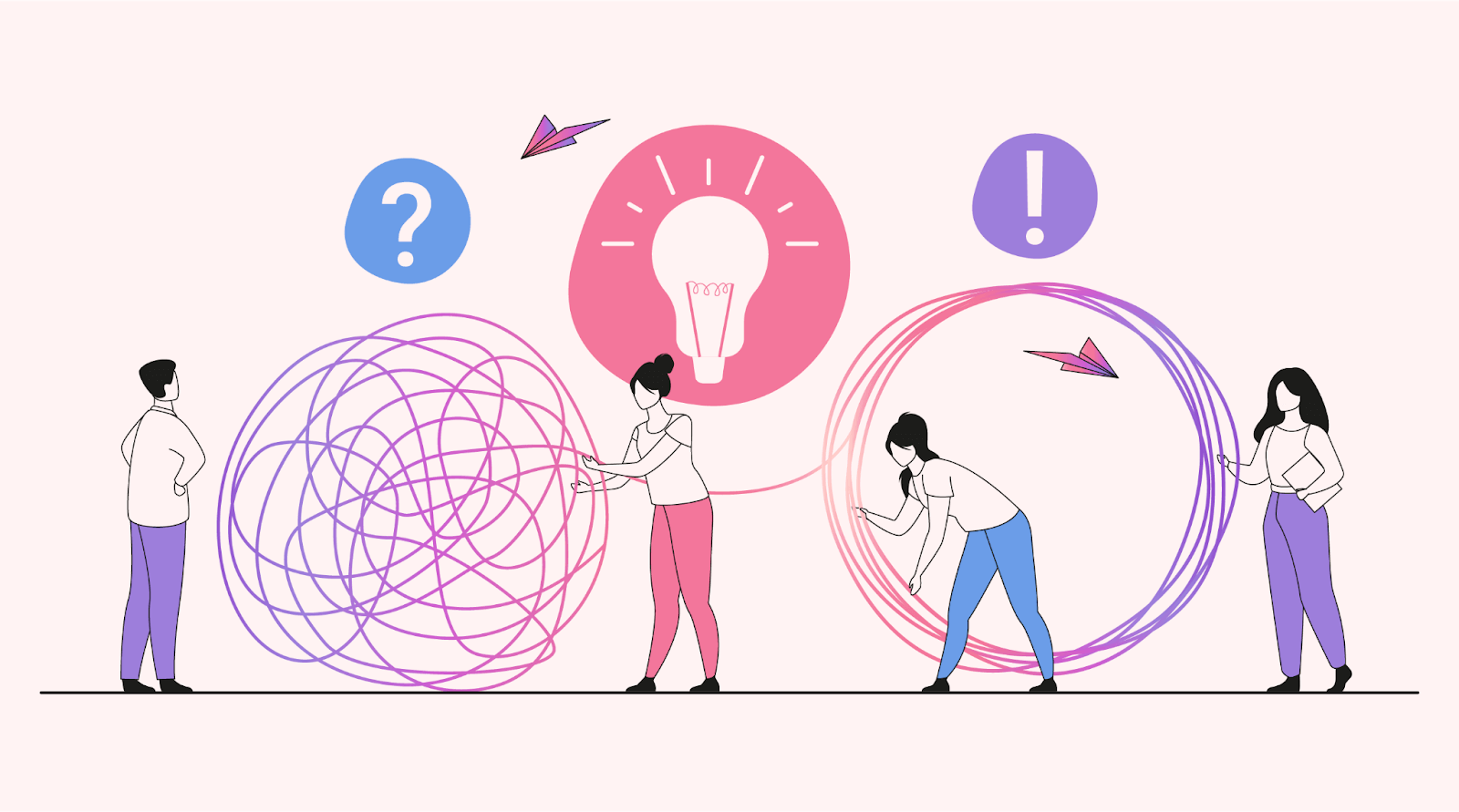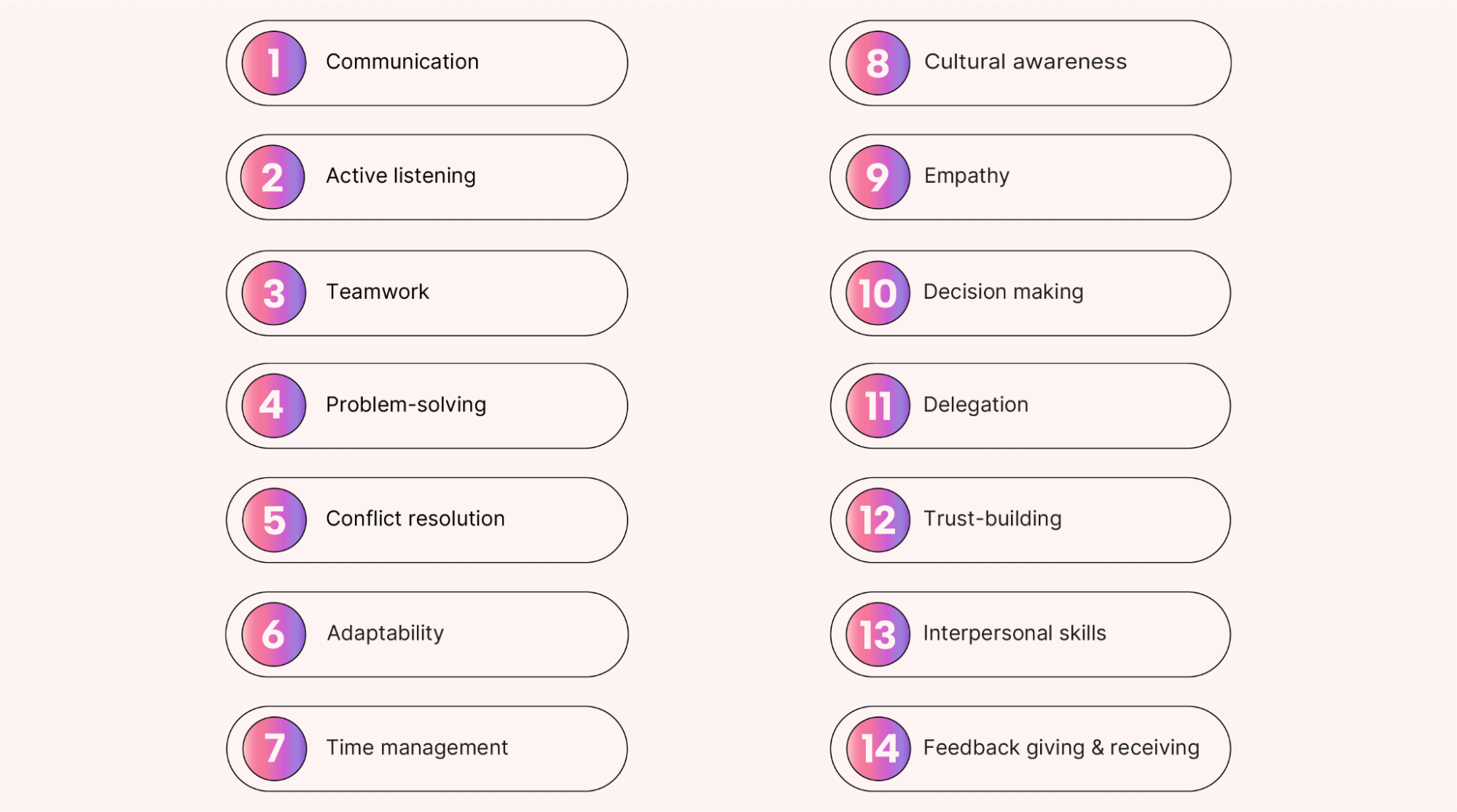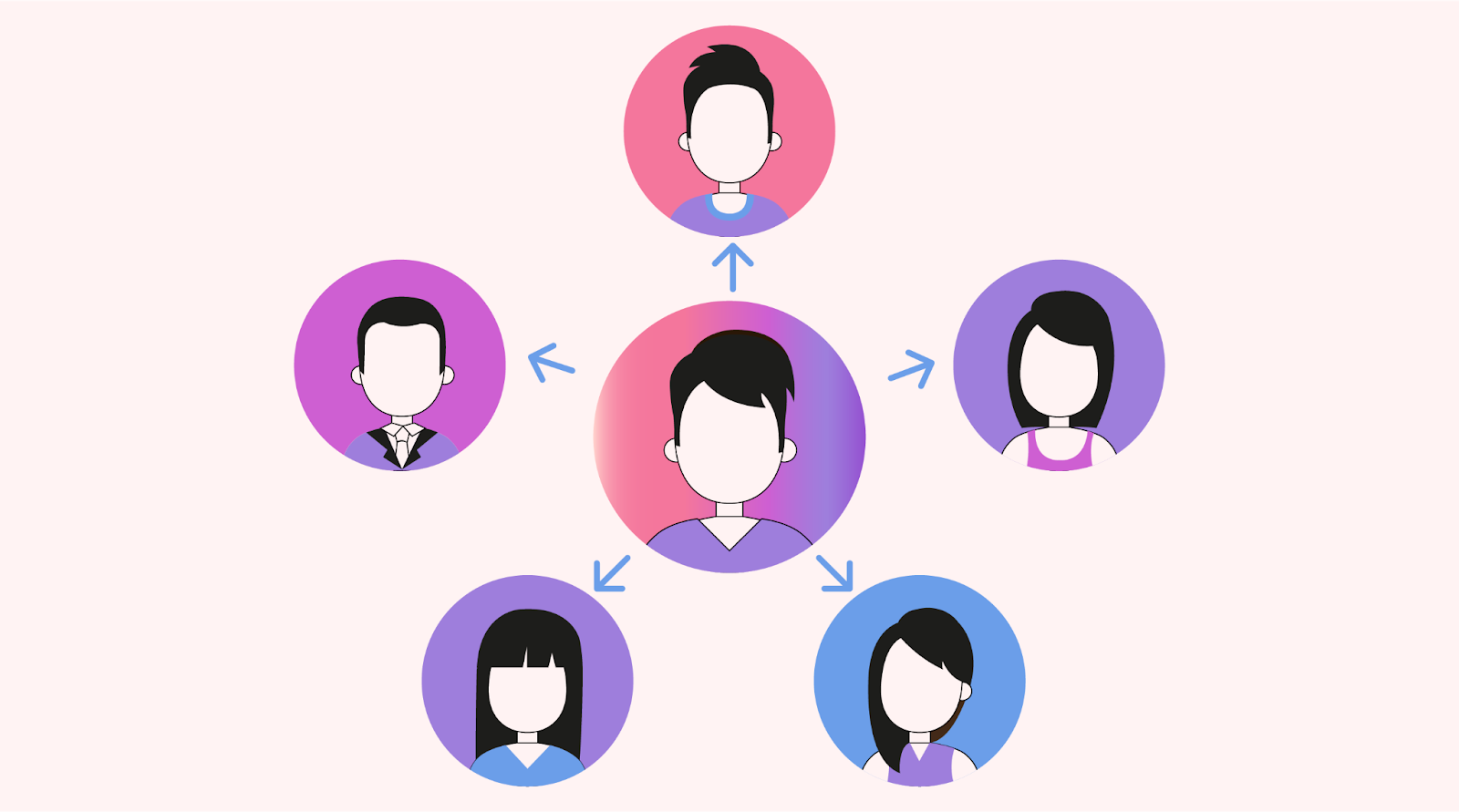Working well with others is more important than ever. As teams grow and jobs get trickier, the ability to collaborate smoothly is a must-have.
Collaboration means using a mix of skills, such as talking clearly, listening well, and understanding different points of view, to work with others.
In this article, we look at 14 key skills that help people work together better and explain why they matter so much. Let’s discover how to team up and get things done!
What are collaboration skills?
Collaboration skills enable individuals to work effectively with others — whether within a team or across different teams and organizations. They facilitate constructive interactions, shared decision-making, and the collective achievement of goals. Understanding group dynamics, fostering open communication, building mutual respect, and promoting a shared vision are all part of healthy collaboration.
Why are collaboration skills important?
Collaboration skills are essential for a multitude of reasons, especially in today’s rapidly evolving, interconnected world. Here’s why they matter:
Enhanced productivity
Teams can pool their strengths, making the workload lighter and more manageable for everyone. As a result, their tasks can be completed faster and with greater efficiency.
Better team innovation and creativity
Diverse minds bring diverse ideas. Collaboration allows for a fusion of perspectives, leading to more innovative solutions and creative outcomes.
Improved problem-solving
Two heads are often better than one. Working together means teams can bring multiple viewpoints to the table, making it easier to find solutions to complex problems.
 |
Collective learning and growth
Collaboration allows for the sharing of knowledge and expertise. Individuals can learn from each other, leading to both personal and professional growth.
Strong team relationships
Effective collaboration fosters strong relationships and trust among team members. This not only boosts morale but can also lead to a more cohesive, harmonious work environment.
Better use of resources
Collaboration often means sharing resources, whether that means knowledge, tools, or manpower. This leads to optimized use and less waste.
Individual skill enhancement
Working closely with others exposes individuals to a range of skills and competencies, helping them refine their own skill sets.
14 types of collaboration skills
All collaboration skills are multifaceted, and an in-depth understanding of them can significantly enhance collaborative endeavors.
 |
1. Communication
Communication is foundational to collaboration. In fact, according to the Project Management Institute (PMI), poor communication is the number-one reason why projects fail.
Effective team communication skills ensure that everyone understands their roles, the objectives of the task at hand, and how their contributions fit into the larger picture. When team members can articulate ideas, provide feedback, and ask questions with clarity, the collaborative effort becomes more streamlined, productive, and free of misunderstandings.
2. Active listening
Active listening involves fully concentrating on, understanding, and responding to a speaker rather than merely “hearing” the message passively. When team members practice active listening, they demonstrate respect for the speaker’s viewpoint and ensure that they accurately capture the essence of what is being shared.
In collaborative settings where diverse perspectives come together, active listening becomes even more essential. It ensures that all voices are acknowledged, valued, and considered, leading to better decision-making and a more inclusive environment.
3. Teamwork
Effective teamwork involves understanding group dynamics, valuing each member’s contributions, and putting team goals above personal ambitions. In collaborative environments, it ensures that responsibilities are distributed, deadlines are met, and projects are completed with collective intelligence.
The power of teamwork is evident in its ability to harness diverse perspectives, skills, and expertise to achieve common goals.
4. Problem-solving
Problem-solving involves identifying challenges, analyzing those challenges’ underlying causes, brainstorming potential solutions, and implementing the most viable option. Team problem-solving should be a collective endeavor.
For instance, when a tech startup encounters a software glitch, it’s not just up to the developers to solve the issue. Marketers must communicate updates to users, customer service must handle inquiries, and leadership must strategize on long-term implications. This integrated approach ensures that the solution is not only technically sound but also considers the broader implications for the business and its customers.
5. Conflict resolution
Given the diverse personalities, backgrounds, and perspectives in a team, disagreements are inevitable. In fact, employees at US companies spend approximately 2.8 hours each week involved in conflict.
However, it’s not the presence of conflict that determines the success of collaboration but how that conflict is managed. Conflict resolution involves understanding the underlying causes of disagreements, mediating discussions, and finding mutually agreeable solutions.
6. Adaptability
A team that’s adaptable is better equipped to not only handle unexpected challenges but also capitalize on new opportunities.
Embracing adaptability fosters a culture of continuous learning and innovation where team members are open to feedback, willing to explore new approaches, and unafraid of change. This fluidity ensures that collaborative efforts remain relevant, efficient, and aligned with evolving objectives and environments.
7. Time management
Effective time management within teams ensures tasks are completed on time. It involves coordinating schedules, prioritizing tasks, and meeting deadlines.
Time management techniques help teams focus on what’s most important since the most crucial tasks are typically addressed first. When all team members know their roles, responsibilities, and deadlines, smoother collaboration is the result.
Teams can use time management tools, like calendars and task lists, as well as project management software, like Motion, to help them manage their time wisely. Doing so helps foster an environment of open communication and mutual respect for each team member’s time and commitments.
8. Cultural awareness
Today’s globalized world means workplaces often include individuals from diverse backgrounds. Cultural awareness, or the understanding and appreciation of these differences, is essential for effective collaboration.
Understanding the nuances of different cultures helps teams avoid misunderstandings and communicate more effectively. For instance, in some cultures, direct feedback may be seen as rude, while in others, it’s appreciated.
9. Empathy
Empathy is about feeling and understanding another’s emotions and thinking about things from their perspective. Demonstrating genuine concern and understanding fosters a safe environment where members can trust each other.
Empathy can also help teams understand the root causes of disagreements, making it easier to address and resolve conflicts.
10. Decision-making
Collaborative decision-making leverages the diverse skills, experiences, and viewpoints of all the members of a team. This involves weighing multiple viewpoints, analyzing options, and making group-beneficial choices, leading to more comprehensive — and potentially better — solutions.
Decision-making within a team directs the course of the group’s efforts and helps ensure that the entire team is collaboratively working toward a shared objective.
11. Delegation
Delegation is about entrusting tasks or responsibilities to other individuals. When teams recognize individual strengths and assign project tasks accordingly, workloads are distributed based on expertise and capacity.
 |
Effective delegation is a vital collaboration skill, as it can optimize productivity, foster trust, and promote team growth.
12. Trust-building
Teams need a safe environment where everyone is confident to share their ideas, voice their concerns, and rely on one another to achieve common goals. Trust unites team members, fostering a sense of camaraderie and mutual respect, both of which are crucial for long-term collaboration success.
13. Interpersonal skills
Interpersonal skills, often referred to as “people skills” or “soft skills,” refer to one’s ability to positively interact, communicate, and work with others.
These skills are essential for successful collaboration, as they facilitate understanding, trust, and effective teamwork among diverse participants.
While technical skills might get a project started, it’s the interpersonal skills that ensure that the project is completed efficiently.
During a product development project, for example, team members from various departments — design, engineering, marketing, for instance — will have different perspectives and priorities. Interpersonal skills enable these individuals to understand each other’s viewpoints, find common ground, and work cohesively.
14. Feedback giving and receiving
Feedback — both giving and receiving it — is essential for individual growth and the collective improvement of a team. It’s a tool that offers insights into performance, behavior, and areas requiring attention.
When approached with an open mind and positive intent, feedback acts as a vital tool in collaboration. It not only ensures alignment and optimization of processes but also fosters a culture of trust and mutual respect.
7 tips for improving your team’s collaboration skills
Not sure how to start developing your team’s collaboration skills? Here are some tips to help you:
1. Establish clear roles
Every team member should know their own responsibilities. When initiating a project, for instance, designate someone as the leader, someone as the researcher, and a third person as the presenter. This helps avoid overlapping duties and ensures everyone is held accountable for their role.
2. Set common goals
Everyone in the team should understand and work toward a shared objective. Shared goals foster a sense of belonging and purpose. When everyone is working toward the same objectives, camaraderie results since each person feels they are part of something larger than their individual tasks.
3. Celebrate successes
When teams achieve goals or reach milestones, celebrate them. This could be as simple as congratulating a team member for a well-done presentation or throwing a small party after the team finishes a project. Regularly acknowledging and celebrating team achievements boosts morale and fosters a sense of community.
 |
4. Respect differences
Teams are diverse, and this diversity is a strength. Recognize and appreciate each member’s unique perspective. If a team member from a different culture suggests an alternative approach, consider it and integrate it where appropriate.
5. Create a constructive feedback loop
Constructive feedback creates an environment where team members feel comfortable expressing their thoughts, concerns, and ideas. This type of dialogue improves team dynamics and helps ensure that miscommunications are addressed swiftly. Regularly giving and receiving feedback prevents smaller issues from escalating into larger conflicts.
6. Use collaboration tools
There’s an overwhelming number of collaboration tools available today. Among them, Motion shines as an exceptional choice. Motion streamlines communication and task management, acting as a centralized hub for all team projects and tasks, ensuring seamless collaboration and optimal productivity.
7. Commit to continuous learning
Encourage team members to upskill through workshops, courses, or shared learning from other team members. Maybe a graphic designer can learn a bit about copywriting and vice versa. This not only improves individual capabilities but also increases team flexibility.
Collaboration skills in action
Here are some scenarios that illustrate how teams can use their collaboration skills effectively:
1. Brainstorming sessions
In a vibrant conference room, team members from various departments gather around a table filled with sketch pads, markers, and sticky notes. Ideas — some audacious, some conservative — fly.
Effective communication ensures every suggestion is heard, while active listening allows team members to build upon one another’s ideas. The environment is non-judgmental, fostering trust and ensuring that even the quietest members contribute and feel valued.
 |
By the end of the session, the whiteboard is awash with colorful suggestions, all pointing toward innovative solutions.
2. Cross-functional projects
A company’s engineering department collaborates with marketing, sales, and design. Each team brings a unique perspective. Through interpersonal skills and cultural awareness, the four teams bridge the jargon gap, ensuring seamless communication.
Delegation based on expertise helps ensure that tasks are assigned to those best suited for them. Regular meetings ensure feedback is shared, ensuring the project remains on track and is refined as necessary.
3. Conflict resolution meetings
In a neutral space, two team members with differing views on a project’s direction sit down with a mediator. Active listening is crucial, as it ensures each party fully understands the other’s viewpoint. Empathy allows each participant to appreciate the other’s concerns.
With a focus on problem-solving, both parties collaborate to find a middle ground that respects their individual perspectives while prioritizing the project’s success.
4. Team workshops
A facilitator leads team members through a series of exercises aimed at enhancing their skill sets. Open communication helps in addressing learning needs, while peer feedback ensures real-time learning.
This atmosphere is one of mutual respect and growth, with each member sharing insights from their experiences. This ultimately leads to collective upskilling.
5. Peer reviews
A software developer shares their code with a colleague for review. The reviewer, using constructive feedback, points out areas for improvement while appreciating the code’s strengths.
Trust ensures that feedback is received in the spirit of growth, not criticism. This process not only refines the output but strengthens the bond between peers.
6. Remote team collaboration
When team members are time zones apart, they use digital tools to collaborate on a project. Effective communication is even more crucial in this virtual setting. Regular video calls foster a sense of connection. Time management ensures that members in varying time zones can still sync up. Shared online documents, regular updates, and a culture of trust ensure that even without a physical office, the team can operate as a cohesive unit.
7. Trust-building activities
Outside the usual office setting, team members participate in activities ranging from escape rooms to weekend retreats. These exercises, while fun, emphasize teamwork, problem-solving, and, often, conflict resolution. Teams forge stronger bonds as they overcome challenges together, fostering an environment of mutual respect and trust.
Unlock the power of your team’s collaboration skills with Motion
Collaboration skills aren’t just about getting along with others — they are pivotal in driving results, fostering innovation, and ensuring the overall success of a team or organization. However, developing collaboration skills within a diverse team can be a challenge, given the different perspectives, strengths, and approaches each member brings to the table.
In today’s digital age, we’re fortunate to have tools designed specifically to bridge these differences and amplify collaborative efforts.
Motion’s collaborative features, which include AI-powered task prioritization, centralized project organization, and optimized scheduling, stand out from the rest by not only streamlining teamwork but also nurturing an environment where every voice is valued.
Dive into Motion’s world of seamless collaboration by signing up now for a 7-day free trial.





